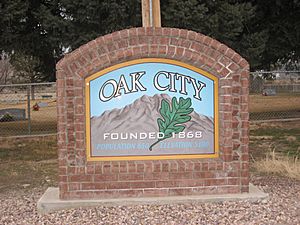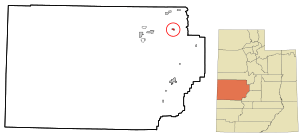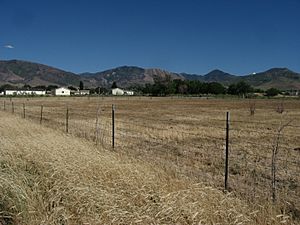Oak City, Utah facts for kids
Quick facts for kids
Oak City, Utah
|
|
|---|---|

Welcome sign
|
|

Location in Millard County and the state of Utah.
|
|
| Country | United States |
| State | Utah |
| County | Millard |
| Area | |
| • Total | 0.94 sq mi (2.44 km2) |
| • Land | 0.94 sq mi (2.44 km2) |
| • Water | 0.00 sq mi (0.00 km2) |
| Elevation | 5,095 ft (1,553 m) |
| Population
(2010)
|
|
| • Total | 578 |
| • Density | 689.69/sq mi (266.25/km2) |
| Time zone | UTC-7 (Mountain (MST)) |
| • Summer (DST) | UTC-6 (MDT) |
| ZIP code |
84649
|
| Area code(s) | 435 |
| FIPS code | 49-55430 |
| GNIS feature ID | 2413060 |
Oak City is a small town located in Millard County, Utah, United States. In 2010, about 578 people lived there. It's a quiet place with a rich history and a strong community spirit.
Contents
Where is Oak City?
Oak City is in the state of Utah. It covers an area of about 0.94 square miles (2.44 square kilometers). All of this area is land, meaning there are no large lakes or rivers within the town limits.
What is the climate like in Oak City?
Oak City has a cold semi-arid climate. This means it's generally dry, but it can get quite cold, especially in winter. The summers are usually hot.
| Climate data for Oak City, Utah, 1991–2020 normals, extremes 1905–present | |||||||||||||
|---|---|---|---|---|---|---|---|---|---|---|---|---|---|
| Month | Jan | Feb | Mar | Apr | May | Jun | Jul | Aug | Sep | Oct | Nov | Dec | Year |
| Record high °F (°C) | 68 (20) |
75 (24) |
83 (28) |
87 (31) |
100 (38) |
105 (41) |
109 (43) |
105 (41) |
100 (38) |
97 (36) |
86 (30) |
68 (20) |
109 (43) |
| Mean maximum °F (°C) | 53.8 (12.1) |
60.4 (15.8) |
70.9 (21.6) |
78.9 (26.1) |
88.3 (31.3) |
96.7 (35.9) |
101.7 (38.7) |
98.7 (37.1) |
93.1 (33.9) |
81.9 (27.7) |
68.2 (20.1) |
56.8 (13.8) |
102.2 (39.0) |
| Mean daily maximum °F (°C) | 38.6 (3.7) |
44.2 (6.8) |
54.7 (12.6) |
61.3 (16.3) |
72.6 (22.6) |
84.9 (29.4) |
93.3 (34.1) |
90.9 (32.7) |
81.0 (27.2) |
65.6 (18.7) |
50.7 (10.4) |
39.1 (3.9) |
64.7 (18.2) |
| Daily mean °F (°C) | 29.3 (−1.5) |
34.1 (1.2) |
42.7 (5.9) |
48.6 (9.2) |
58.9 (14.9) |
70.4 (21.3) |
78.8 (26.0) |
76.7 (24.8) |
66.7 (19.3) |
52.7 (11.5) |
39.3 (4.1) |
29.3 (−1.5) |
52.3 (11.3) |
| Mean daily minimum °F (°C) | 20.1 (−6.6) |
23.9 (−4.5) |
30.8 (−0.7) |
36.0 (2.2) |
45.3 (7.4) |
55.8 (13.2) |
64.3 (17.9) |
62.4 (16.9) |
52.5 (11.4) |
39.7 (4.3) |
28.0 (−2.2) |
19.5 (−6.9) |
39.9 (4.4) |
| Mean minimum °F (°C) | 5.3 (−14.8) |
9.1 (−12.7) |
18.7 (−7.4) |
24.4 (−4.2) |
31.8 (−0.1) |
41.2 (5.1) |
53.9 (12.2) |
52.0 (11.1) |
37.9 (3.3) |
25.6 (−3.6) |
13.6 (−10.2) |
3.4 (−15.9) |
−0.2 (−17.9) |
| Record low °F (°C) | −28 (−33) |
−28 (−33) |
−6 (−21) |
3 (−16) |
20 (−7) |
26 (−3) |
33 (1) |
32 (0) |
17 (−8) |
4 (−16) |
−11 (−24) |
−26 (−32) |
−28 (−33) |
| Average precipitation inches (mm) | 1.26 (32) |
1.31 (33) |
1.83 (46) |
1.80 (46) |
1.45 (37) |
0.70 (18) |
0.42 (11) |
0.56 (14) |
0.86 (22) |
1.35 (34) |
0.99 (25) |
1.37 (35) |
13.90 (353) |
| Average snowfall inches (cm) | 7.2 (18) |
6.5 (17) |
5.9 (15) |
2.8 (7.1) |
0.1 (0.25) |
0.0 (0.0) |
0.0 (0.0) |
0.0 (0.0) |
trace | 0.4 (1.0) |
3.6 (9.1) |
6.8 (17) |
33.3 (85) |
| Average precipitation days (≥ 0.01 in) | 6.0 | 5.9 | 6.5 | 6.7 | 6.6 | 2.9 | 3.0 | 3.3 | 3.9 | 4.8 | 4.6 | 5.7 | 59.9 |
| Average snowy days (≥ 0.1 in) | 3.1 | 2.4 | 2.4 | 1.1 | 0.1 | 0.0 | 0.0 | 0.0 | 0.1 | 0.3 | 1.5 | 3.2 | 14.2 |
| Source: NOAA | |||||||||||||
Who lives in Oak City?
| Historical population | |||
|---|---|---|---|
| Census | Pop. | %± | |
| 1890 | 186 | — | |
| 1900 | 249 | 33.9% | |
| 1910 | 423 | 69.9% | |
| 1920 | 326 | −22.9% | |
| 1930 | 340 | 4.3% | |
| 1940 | 391 | 15.0% | |
| 1950 | 334 | −14.6% | |
| 1960 | 312 | −6.6% | |
| 1970 | 278 | −10.9% | |
| 1980 | 389 | 39.9% | |
| 1990 | 587 | 50.9% | |
| 2000 | 650 | 10.7% | |
| 2010 | 578 | −11.1% | |
| 2019 (est.) | 649 | 12.3% | |
| U.S. Decennial Census | |||
In 2000, there were 650 people living in Oak City. Most people lived in families, with many households having children under 18. The average family size was quite large. The median age was 22 years old, which means half the population was younger than 22 and half was older. This shows that Oak City has a lot of young people and families.
How was Oak City founded?
Oak City was first settled in the late summer of 1868. A few families moved there from a nearby community called Deseret, Utah. They had tried for eight years to build a dam on the Sevier River to get water for their farms, but it didn't work out.
These early settlers already knew the Oak City area well. They had used it to feed their cattle in the spring and fall. They chose this new spot because it had a reliable creek for water and good land for farming.
The town was settled in two main steps. First, in July 1868, some families and young men arrived. Their job was to map out the town, clear land for farming, and build shelters for the winter. Then, in October and November of that same year, 23 more families joined them.
Oak City and the A-Bomb Project
Did you know that Oak City was once considered for a top-secret project during World War II? In October 1942, a man named Maj. John Dudley was looking for a place to build a special laboratory for the Manhattan Project. This project was working to develop the first atomic weapons.
Oak City was his first choice! Dudley described it as a "delightful little oasis" in central Utah. It was close to a railroad and an airport, and it had a good water supply. It was also surrounded by hills and desert, which made it a good hidden location.
However, Dudley noticed a problem: if they chose Oak City, many families would have to move, and a lot of valuable farmland would be lost. Because of this, he suggested another place in New Mexico. In the end, the project's scientific director, J. Robert Oppenheimer, chose Los Alamos instead.
What are Oak City's celebrations?
Oak City Days: A Community Party
Every year, in the third week of August, the people of Oak City celebrate "Oak City Days." This is a two-day event that honors the founding of their town. It used to be called "ward days" or "homecoming."
The celebration kicks off on Friday evening with a fun parade. After the parade, everyone enjoys an ice cream social. There's also a special program and friendly competitions, like a Rook card game tournament.
On Saturday, the town prepares a big lunch that feeds over 1,000 people! The day is filled with craft booths, games for kids (including a children’s fish catch), and activities for adults. The festivities wrap up with a dance under the stars, with music played by a local band called The Moonlighters. It sounds like a great time for everyone!
See also
 In Spanish: Oak City (Utah) para niños
In Spanish: Oak City (Utah) para niños


